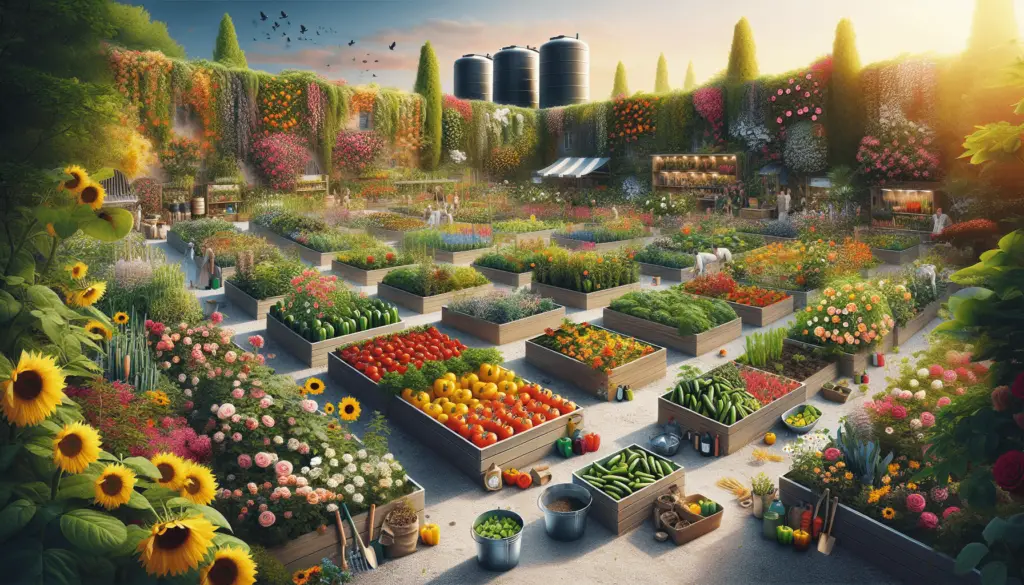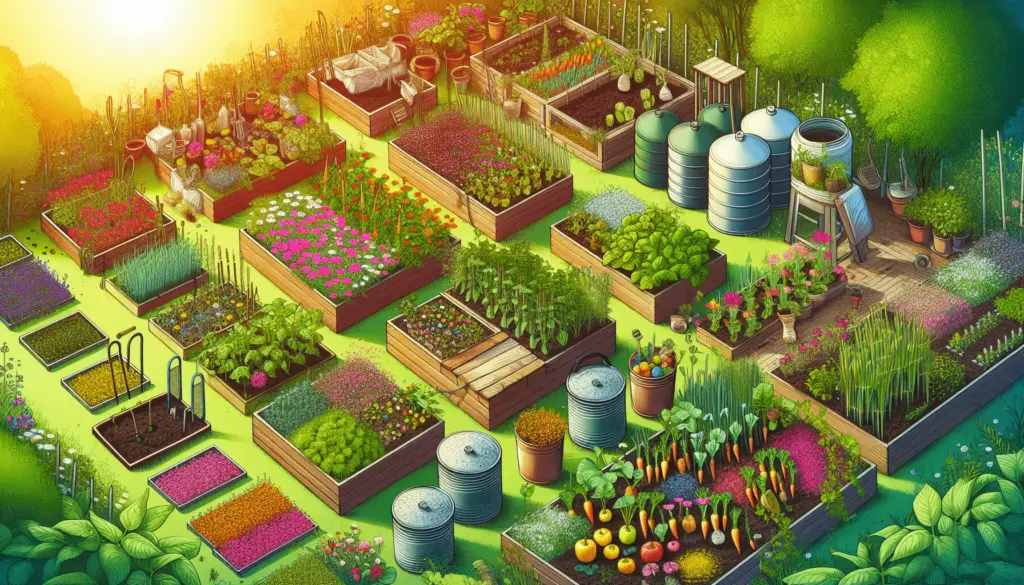Creating a sustainable community garden can bring neighbors together, provide fresh produce, and promote environmental awareness. By following these tips for building a successful and eco-friendly garden, you can work towards creating a thriving and resilient community space that benefits everyone involved. From choosing the right location to implementing water-saving techniques, every step you take can make a positive impact on the environment and foster a sense of community among gardeners. So roll up your sleeves, grab a shovel, and get ready to start building a beautiful and sustainable community garden today. Have you ever wanted to create a community garden in your neighborhood but didn’t know where to start? Building a sustainable community garden can be a rewarding experience that brings people together, promotes healthy living, and contributes to a more environmentally friendly community. In this article, we will provide you with tips and advice on how to create a successful and sustainable community garden that will benefit everyone involved.
Understanding the Basics of Community Gardening
Before you start planning your community garden, it’s important to understand the basics of community gardening. Community gardening is a collaborative effort where individuals come together to cultivate and maintain a shared outdoor space for growing fruits, vegetables, flowers, and herbs. These gardens can vary in size and design, but the common goal is to promote community engagement, education, and sustainability.
Benefits of Community Gardening
Community gardens offer a wide range of benefits for individuals and neighborhoods. They provide access to fresh and healthy produce, promote physical activity, encourage social interaction, and enhance the overall beauty of the community. By participating in a community garden, you can improve your physical and mental well-being, learn valuable gardening skills, and develop lasting friendships with your neighbors.
Planning Your Community Garden
When planning your community garden, there are several key factors to consider to ensure its success. From selecting a suitable location to organizing community involvement, each step plays a crucial role in creating a sustainable and thriving garden. Let’s explore some tips for planning your community garden:
Choosing the Right Location
The first step in creating a community garden is to choose a suitable location that receives an adequate amount of sunlight, has access to water, and is easily accessible to the community members. Look for areas with fertile soil, good drainage, and minimal exposure to strong winds. Consider the size of the garden, the type of plants you want to grow, and the availability of resources such as tools and equipment.
Securing Permission and Support
Before you start developing your community garden, it’s essential to secure permission from the property owner or land manager. This could be a local government agency, a community organization, or a private individual. Work with the appropriate authorities to obtain any necessary permits, agreements, or insurance coverage to protect the garden and its participants. Seek support from local businesses, schools, and community groups to gather resources, volunteers, and funding for your garden project.
Creating a Garden Committee
Forming a garden committee is a great way to get community members involved in the planning and management of the garden. Recruit a diverse group of individuals with different skills and interests to help oversee various aspects of the garden, such as planning, fundraising, maintenance, and outreach. Establish clear roles and responsibilities for committee members, hold regular meetings to discuss progress and issues, and foster a sense of teamwork and collaboration among the group.

Designing Your Community Garden
The design of your community garden plays a significant role in its functionality, aesthetics, and sustainability. By creating a well-organized and visually appealing layout, you can maximize the use of space, facilitate garden activities, and create an inviting environment for community members. Here are some tips for designing your community garden:
Layout and Infrastructure
Consider the layout and infrastructure of your community garden to make it user-friendly and efficient. Divide the space into individual garden plots or sections for different purposes, such as vegetable beds, flower borders, seating areas, compost bins, and tool sheds. Create pathways and borders to define the garden areas, install irrigation systems for watering plants, and provide seating and shade for relaxation and socializing.
Plant Selection and Placement
Choose a diverse selection of plants that are well-suited to your local climate, soil conditions, and light exposure. Include a mix of vegetables, fruits, herbs, and flowers to attract pollinators, improve soil health, and enhance the beauty of the garden. Consider companion planting techniques to maximize crop yields, deter pests, and promote biodiversity. Place plants strategically based on their size, growth habits, and water requirements to ensure they thrive and coexist harmoniously.
Sustainable Practices
Incorporate sustainable gardening practices into the design of your community garden to reduce waste, conserve resources, and minimize environmental impact. Use organic gardening methods, such as composting, mulching, and natural pest control, to maintain soil fertility and improve plant health. Install rain barrels or cisterns to collect rainwater for irrigation, plant native species to support local wildlife, and encourage community members to recycle, reuse, and upcycle materials in the garden.
Establishing Garden Guidelines
Setting clear guidelines and rules for your community garden is essential to ensure that all participants can enjoy the space cooperatively and respectfully. By establishing a set of guidelines, you can promote a harmonious and inclusive garden community, address potential conflicts or misunderstandings, and maintain the quality and sustainability of the garden. Here are some tips for establishing garden guidelines:
Participation and Responsibilities
Specify the rules for participating in the community garden, such as membership requirements, plot sizes, fees, and work commitments. Outline the responsibilities of gardeners, such as planting, weeding, watering, and harvesting their plots, as well as contributing to communal tasks, events, and maintenance projects. Encourage cooperation, communication, and accountability among garden members to foster a sense of ownership and shared responsibility for the garden’s success.
Behavior and Conduct
Establish guidelines for appropriate behavior and conduct in the community garden to create a safe, welcoming, and inclusive environment for everyone. Address issues such as vandalism, theft, littering, and unauthorized use of garden resources, and outline the consequences for violating the rules. Promote mutual respect, cooperation, and cooperation among gardeners, and encourage open communication and conflict resolution to address any issues or concerns that may arise.
Sustainability and Conservation
Promote sustainability and conservation practices in the community garden by encouraging gardeners to adopt environmentally friendly gardening techniques and reduce their ecological footprint. Emphasize the importance of water conservation, waste reduction, and soil health in maintaining a healthy and productive garden. Educate garden members on sustainable gardening practices, such as composting, mulching, and using organic fertilizers, to help them make informed decisions that benefit the environment and future generations.

Maintaining Your Community Garden
After establishing your community garden, it’s essential to maintain and manage the garden to ensure its long-term success and sustainability. Regular care and maintenance of the garden will help preserve its beauty, productivity, and value for the community. Here are some tips for maintaining your community garden:
Garden Care and Maintenance
Develop a maintenance schedule and task list to help gardeners stay on track with their responsibilities and keep the garden in top condition. Organize regular workdays, workshops, and educational events to engage the community in garden-related activities and promote teamwork and camaraderie among members. Monitor the health of plants, soil, and wildlife in the garden, and address any issues or problems promptly with appropriate solutions.
Seasonal Tasks and Projects
Plan seasonal tasks and projects to ensure that your community garden thrives year-round and adapts to changing weather conditions and plant needs. Consider planting seasonal crops, cover crops, and companion plants to maximize productivity, attract pollinators, and improve soil fertility. Rotate crops, refresh mulch, and clean up garden beds to prevent disease outbreaks, reduce pests, and maintain a tidy and well-organized garden space.
Community Engagement and Events
Engage the community in the maintenance and management of the garden by organizing group activities, events, and workshops that promote social interaction, education, and fun. Host garden tours, potlucks, seed swaps, and harvest celebrations to celebrate the achievements of the garden and connect with neighbors. Invite local schools, businesses, and organizations to participate in community garden projects, fundraisers, and outreach programs to raise awareness and support for the garden’s mission and goals.
Conclusion
Creating a sustainable community garden is a rewarding and fulfilling experience that brings people together, promotes healthy living, and contributes to a greener and more resilient community. By following the tips and advice outlined in this article, you can successfully plan, design, establish, and maintain a thriving community garden that benefits everyone involved. Remember to involve the community in every step of the process, prioritize sustainability and conservation practices, and enjoy the fruits of your labor as you watch your garden grow and thrive. Happy gardening!
